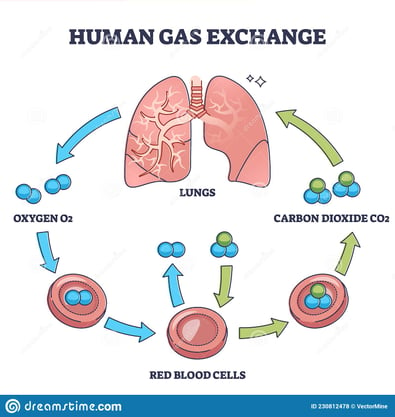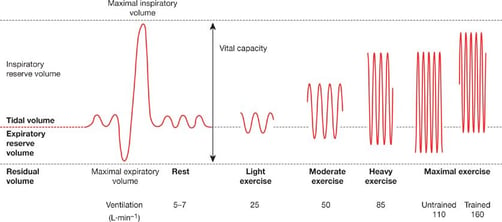Inside My Body When I Run: Breathing
September 14, 2022
What comes to mind when you think about training for running? Have you ever considered what is happening inside when you're breathing heavily, your blood is pumping, and you're getting exhausted? Chances are most people have never considered what's actually going on besides the agony that is felt during a long run or an interval training session. In this blog, we'll aim to help you understand why and what-the-hell is going on in your airways, lungs, and blood, and how that information can be applied to your training. As outlined in Episode 1, the better you understand some of these concepts, the more confident you can be that you're training appropriately.
What Your Body Does With Air

Let me paint a picture for you: You start a long-ish run at an easy pace, your heart rate is low, and your breathing is comfortable...but what's going on inside your body? As you breathe in air, the 21% of it that contains oxygen is transported from your lungs to your bloodstream, where red blood cells carry it to the areas of your body in need. As you increase the intensity of your exercise or deplete the energy that's already in your muscles, you'll need to increase the rate at which you breathe and the rate of blood flow by increasing your heart rate.
Fun fact: You can increase the number of red blood cells in your body by training! Normal amounts of RBCs for men are around 40-50% and for women 35-45%. This is why a common form of doping in sports is an injection of more RBCs into the bloodstream - more places for oxygen to live in the blood.
So what does that mean for you in your training? It comes down to the use of energy, quantified as metabolic equivalents (METs). Check out this chart to get the gist of how much energy you need per activity.
| Activity/Intensity (1mile) | Approximate METs | VO2 needed (approx. ) ml/kg/min |
| Walking 3mph | 3.5 | 12 |
| Running 5mph | 8.3 | 22 |
| Running 6mph | 9.8 | 27 |
| Running 7mph | 11 | 33 |
| Running 8mph | 11.8 | 38 |
| Running 9mph | 12.8 | 43 |
| Running 10mph | 14.5 | 48 |
| Running 11mph | 16 | 55 |
| Running 12mph | 19 | 59 |
| Running 13mph | 19.8 | 65 |
| Running 14mph | 23 | 70 |
How to Know Your Individual Breathing Needs
With that chart as a reference for approximately how much energy you use at the paces you'd like to run, and a reference for the VO2 (Volume of Oxygen Consumed) that you need for that pace, you're probably wondering how efficiently your body handles energy and oxygen consumption. There are two ways of going about this:
AT HOME APPROXIMATE TEST
Set yourself up on a track, or another contained environment for a Cooper Test. This test is performed by starting a 12 minute clock and running as far as you can in that time. You can click here for a reference of the results in order to approximate your VO2 using this formula:
Approximate VO2 max = (36 X Number of miles covered) - 11.3
LAB TESTING/VO2MAX TESTING
At MOTIVNY we use the PNoE ventilation mask and testing equipment to get you a lab-grade measurement of your Resting Metabolic Rate as well as your VO2 Max. This test is done in a ramped method of increasing intensity to measure your body's true maximal aerobic capacity. We'll get more into what that means in the Metabolism and Fueling episode of this series.
What's Considered "Normal" for Breathing While Running?
Keep in mind that your VO2 max is usually measured compared to your body weight, so you may see very different relative numbers when you compare yourself to your friends. Larger males may have the same VO2max as more average-sized females, but they have to use a lot more volume of air and energy in order to achieve that number. This is one of the main reasons why elite runners generally have slim builds and very low body fat percentages. Here's a norms chart to give you an idea:
WOMEN

MEN

Source: https://www.garmin.com/en-SG/blog/whats-a-good-vo2-max-for-me/
Best Ways To Improve Breathing And O2 Volume While Running
Hopefully, it's clear now that increasing your running intensity not only requires attention to muscles and running paces, but also to your breathing and cardiovascular function. Certain activities and program designs (to be discussed in Ep. 5 in-depth) will create responses in your physiology to be able to breathe more, faster, and larger, while also signaling your body's cells to get ready to make more energy and utilize all of this new oxygen being received.
 Source: https://thoracickey.com/respiratory-system-response-to-exercise-in-health/
Source: https://thoracickey.com/respiratory-system-response-to-exercise-in-health/
Being able to breathe more volume, use more oxygen, and offload more carbon dioxide is only going to happen if you're achieving higher intensities of exercise. If you're the type of runner that goes out for a 3-5 mile run at a "jog" intensity, this might explain why you're not seeing huge gains in your overall fitness level. You simply haven't challenged the body to have the need for more oxygen demand. You'll want to get started with some interval training workouts.
Another strategy during your runs is to explore Rhythmic Breathing. This concept refers to the ratio of steps taken while running to your inhale or exhale. As a beginner, try to go with a 2:3 ratio; or 2 steps for your inhale and 3 steps for your exhale. This should ensure that you're not getting too stiff while you run and that you're breathing efficiently.
It is important to state here that low-intensity runs are not un-useful! Interval training is best used to increase your VO2max, which is one measurement of your overall fitness level. But if you are training for a marathon, for example, your VO2max is only one of many factors that influence how you perform on race day, and research has shown that low-intensity runs are one of the best ways to improve your running endurance while also avoiding overtraining injuries.
What You Can Do When You Aren't Running
In addition to interval training and higher intensity runs, you may be able to make gains by raising your baseline level of breathing.
Maximal Expansive Breathing
This is a concept from the Functional Range Conditioning (FRC) framework which asks that a student explore the expansion of their trunk in a more uniform way. Often we have breathing preferences that predispose us to the expansion of the lungs and torso in one area, and not in others. A common pitfall is excessive chest breathing, or excessive belly breathing without expansion into the back spaces because of muscle tightness and resistance in those areas. With training, you can reduce that muscle tension and increase your functional lung volume.
Breath Holding
Practicing holding your breath is beneficial to condition the body to the build-up of CO2 in the system, and also to keep the tissue in the torso in a more 'stretched' or expanded position for a longer period of time. As you practice breath holds, you'll find the time you can hold comfortably goes up rapidly, and that your body will respond less stressfully to the urge for more oxygen.
Altitude Exposure
Being at altitude provides a lower partial pressure of oxygen in the air we breathe. Because of this, the normal 21% O2 is reduced, and the body adapts by creating more red blood cells to carry oxygen molecules. This adaptation is not instantaneous, and probably only applies to elite and professional level athletes.
Posture and Muscle Tension
Slouched posture has been found to reduce Vital Capacity when compared to a more erect posture. Likely a result of increased muscle tension on the front of the chest wall, as well as weakness of breathing muscles, the athlete will not be able to make use of their full lung volume. Imagine being wrapped in a corset or really tight clothes, and how that would restrict the ability to take in air. One good way to start addressing these issues is to see a Physical Therapist who will assess your specific issues, or take a Kinstretch class at MOTIVNY to start exposing yourself to a broad spectrum of movements.

LUKE GREENBERG
Manual Medicine, Kettlebells and Golf Training, Team Dad

